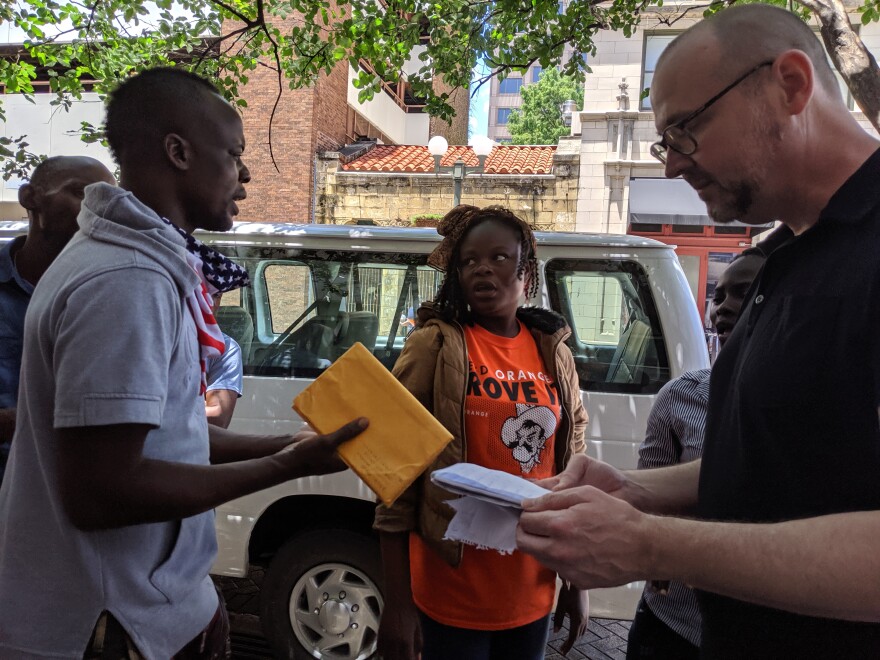Hundreds of Central African migrants, trying to escape poverty and violence, crossed the U.S. southern border the first week of June. They're in San Antonio now trying to figure out what's next.
"My name is Michele. I'm from Congo. Now I'm in Texas, San Antonio."
Michele, his wife and three children are among those hundreds. They’re from Kinshasa, the capital of the Democratic Republic of Congo. It's a city of 11 million people.
Peter Stranges works for Catholic Charities in San Antonio, but his job isn't to work with migrants. He's the vice president of programs there, and he also speaks French. That's why he was outside the city's migrant services center last week, talking to a cluster of young men and a woman with a sleeping baby strapped to her back.
"So getting here, a lot of people don’t know what city they’re in when they arrive. They’re also hungry, tired and they’re thirsty, so we’re just helping them reach out and get in contact with sponsors who may be able to help them on their journeys," Stranges said.
These families, from the Democratic Republic of Congo, the Republic of Congo and Angola, have been on the road for a long time. Michele and his family started their journey in January. To get to the U.S., most Central African migrants start with a flight to South or Central America, according to Randy Capps, the director of research for U.S. programs at the Migration Policy Institute.

"Yes they have to fly,” Capps said. “They're flying to somewhere in Latin America before they journey north, and they have to cross several countries. That's not an easy journey."
While the journey isn’t easy, Capps said, it’s preferable to the alternative, which is to make the trip to Europe by boat across the treacherous Mediterranean. In fact, Capps said, many central African asylum seekers don't even make it to the sea. They’re at refugee camps in North Africa.
"Many of them are stuck and languishing in really poor conditions, some in near-slave conditions in Libya right now,” Capps said. “So, when conditions at home are desperate and the Europe option doesn't look good, the high-priced, long distance option to come to the U.S. might be worth it."
And when they get to South America, they find well-traveled roads to follow north.
"That journey through Central America and Mexico has been facilitated by these large migrant caravans, by more sophisticated and faster smuggling routes,” Capps said. “And it's an easier journey from Guatemala onward than it has been in the past."
At the U.S. border, Customs and Border Protection said it's arrested more than 500 Africans since May 30, but hundreds of others have ended up on shuttle vans that drop them off on a busy street corner in downtown San Antonio, near the Greyhound bus station, outside the migrant resource center.
Many of the migrants are headed to Portland, Maine, where there is an established Congolese community. Not Michele though.
"No, no, no. I think I go to New York,” he said. “Now I'm here in Texas, I take some ticket and go to New York."
He worked in hotels in Kinshasa because he speaks French, Portuguese, Spanish and some English. He said he'll do any job he can find here, but it's difficult for an asylum seeker to get a permit to work legally in the U.S., and some never do.

Still, people keep coming. MPI's Randy Capps said the number of asylum seekers at the southern border has been increasing steadily, with people coming from Cuba, Venezuela, South Asia and Africa drawn by the idea that the U.S. immigration system is kind of a mess right now.
"I think the migrant crisis at the U.S. border has been so well publicized and because of all the chaos over policymaking in Washington D.C. it really gives the impression that the U.S. border is open for business right now," Capps said.
That may change if Mexico follows through on a reported plan to add troops at its southern border. But if Mexico does not do that, Capps says you can expect the number of migrants seeking asylum at the southern border to remain high.
Bonnie Petrie can be reached at Bonnie@TPR.org and on Twitter at @kbonniepetrie.


